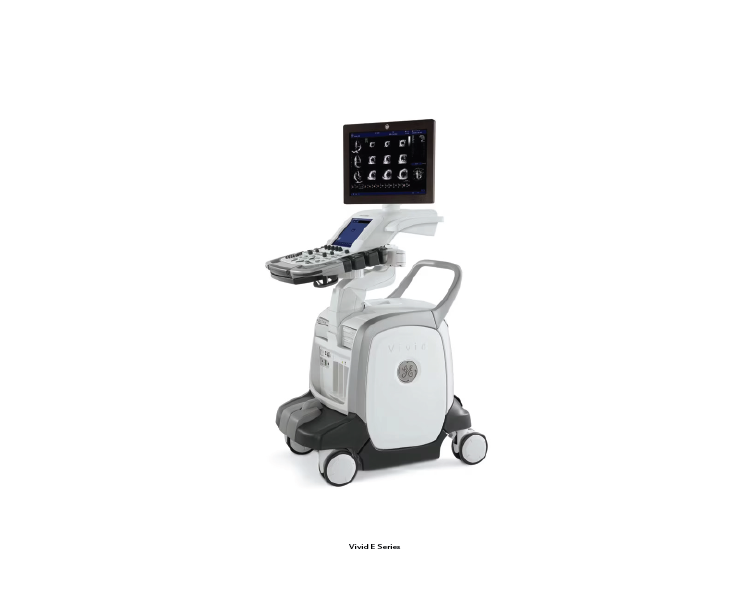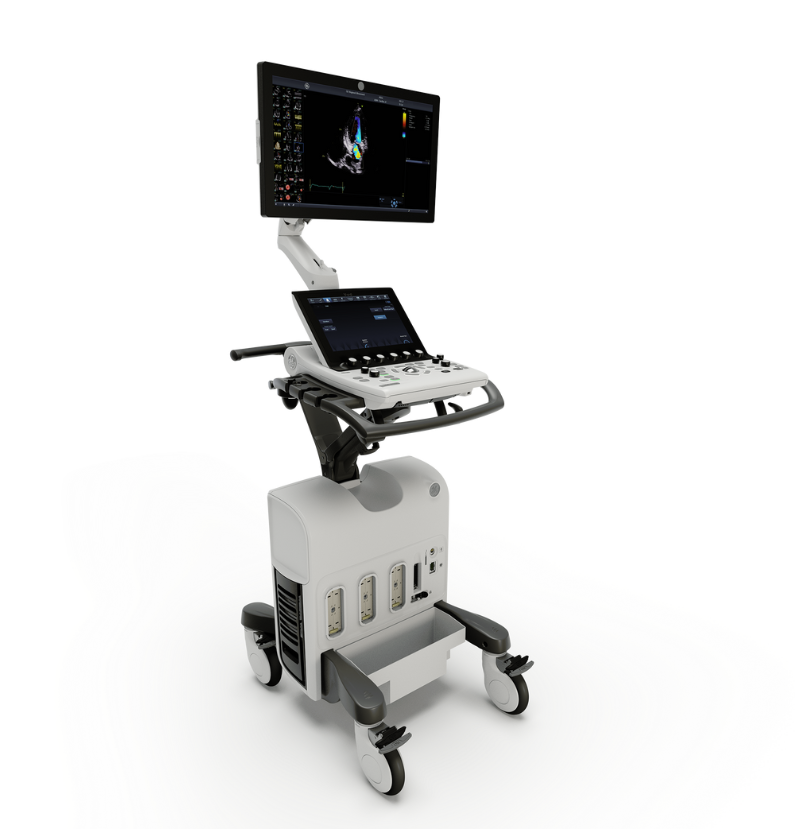Vivid E Series
The Vivid E Series, developed by GE Healthcare, comprises a range of advanced ultrasound systems specifically designed for cardiovascular imaging. These systems are engineered to provide exceptional image quality, detailed anatomical views, and robust diagnostic capabilities. The Vivid E Series aims to meet the diverse needs of cardiologists and other healthcare professionals by offering powerful tools and technologies that enhance diagnostic accuracy and patient care.
Key Features of Vivid E Series
1. Superior Imaging Quality:
• High-Resolution Display: Delivers clear, detailed images with high resolution, enabling precise visualization of cardiac structures and functions.
• Advanced Imaging Modes: Includes features such as harmonic imaging, speckle tracking, and 4D imaging to provide comprehensive cardiac assessments.
2. Advanced Cardiac Imaging Tools:
• Strain Imaging: Allows for detailed assessment of myocardial function by measuring deformation and strain, helping detect subtle changes in cardiac performance.
• Auto-IMT: Automated measurement of intima-media thickness for vascular health assessment, aiding in the evaluation of atherosclerosis.
3. User-Friendly Interface:
• Intuitive Controls: Features a user-friendly interface with easy-to-navigate menus and customizable presets, enhancing workflow efficiency.
• Touchscreen Operation: Some models include touchscreen capabilities for simplified operation and quick adjustments during exams.
4. Comprehensive Connectivity:
• DICOM Compatibility: Ensures seamless integration with hospital information systems (HIS) and picture archiving and communication systems (PACS), facilitating efficient data management.
• Wireless Capabilities: Some models offer wireless data transfer, enhancing mobility and ease of use in different clinical settings.
5. Portable and Ergonomic Design:
• Compact Form Factor: Designed for easy mobility, allowing for use in various clinical environments, including emergency rooms and intensive care units.
• Ergonomic Features: Adjustable monitors and control panels improve user comfort, reducing physical strain during prolonged use.
Clinical Applications of Vivid E Series
1. Adult and Pediatric Cardiology:• Provides detailed imaging and assessment tools for evaluating cardiac structure and function in both adult and pediatric patients, aiding in the diagnosis and management of congenital and acquired heart diseases.
2. Vascular Imaging:
• Advanced vascular imaging capabilities allow for the assessment of blood vessels, helping detect and evaluate conditions such as atherosclerosis, aneurysms, and other vascular abnormalities.
3. Transesophageal Echocardiography (TEE):
• Offers high-resolution TEE imaging for detailed visualization of cardiac structures, crucial for intraoperative monitoring and complex cardiac assessments.
4. Stress Echocardiography:
• Enables the evaluation of cardiac function under stress conditions, useful for detecting ischemia and assessing myocardial viability.
Vivid S Series
The Vivid S Series, developed by GE Healthcare, is a line of premium cardiovascular ultrasound systems designed to deliver high-performance imaging and advanced diagnostic capabilities. These systems are tailored for cardiologists and other healthcare professionals who require precise and detailed cardiac assessments. The Vivid S Series combines innovative technology, user-friendly interfaces, and ergonomic design to enhance diagnostic confidence and improve patient care.
Key Features of Vivid S Series
1. Exceptional Imaging Quality:
• High-Resolution Display: Provides crisp, detailed images with superior resolution, essential for accurate visualization of cardiac structures and functions.
• Advanced Imaging Techniques: Includes features such as harmonic imaging, speckle tracking, and 4D imaging to offer comprehensive cardiac assessments and detailed anatomical views.
2. Advanced Cardiac Assessment Tools:
• Strain Imaging: Enables detailed evaluation of myocardial function by measuring deformation and strain, helping detect subtle changes in cardiac performance.
• Auto-IMT: Automated measurement of intima-media thickness for assessing vascular health and evaluating the risk of atherosclerosis.
• Quantitative Analysis: Advanced quantification tools for assessing ventricular function, valvular assessment, and other cardiac parameters.
3. User-Friendly Interface:
• Intuitive Controls: Features an easy-to-navigate interface with customizable presets and streamlined workflows, making it user-friendly for clinicians.
• Touchscreen Functionality: Some models offer touchscreen capabilities for faster, more efficient operation and adjustments during exams.
4. Comprehensive Connectivity:
• DICOM Compatibility: Ensures seamless integration with hospital information systems (HIS) and picture archiving and communication systems (PACS), facilitating efficient data management and sharing.
• Wireless Capabilities: Enables wireless data transfer, enhancing the system's mobility and ease of use across different clinical settings.
5. Portable and Ergonomic Design:
• Compact and Mobile: Designed for easy transportation and use in various clinical environments, including bedside, emergency rooms, and intensive care units.
• Ergonomic Features: Adjustable monitor and control panel to enhance user comfort and reduce physical strain during prolonged use.
Clinical Applications
1. Adult and Pediatric Cardiology:• Provides comprehensive imaging and assessment tools for evaluating cardiac structure and function in both adult and pediatric patients, aiding in the diagnosis and management of congenital and acquired heart diseases.
2. Vascular Imaging:
• Advanced vascular imaging capabilities allow for detailed assessment of blood vessels, helping detect and evaluate conditions such as atherosclerosis, aneurysms, and other vascular abnormalities.
3. Transesophageal Echocardiography (TEE):
• Offers high-resolution TEE imaging for detailed visualization of cardiac structures, crucial for intraoperative monitoring and complex cardiac assessments.
4. Stress Echocardiography:
• Enables the evaluation of cardiac function under stress conditions, useful for detecting ischemia and assessing myocardial viability.
5. Intraoperative and Interventional Imaging:
• Provides real-time imaging support for intraoperative and interventional procedures, aiding in precise guidance and assessment during surgeries and catheter-based interventions.



.png)